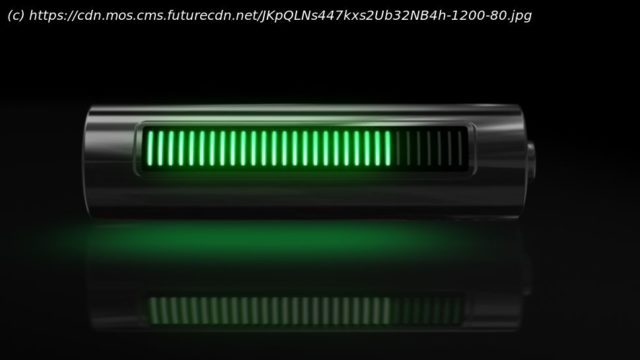The future of batteries will have a far greater effect on our lives than you think.
You might not realize it, but much of our everyday life as we know it depends on the future of batteries. From juicing up your iPhone or laptop to powering your commute, batteries and charging devices give us the ability to enjoy the conveniences and joys of modern life – chances are, you’re reading this article on a battery-powered device. We take the humble battery for granted and trust that our spare pack of AAAs will always be in the kitchen drawer, ready for use, and our Lightning cables waiting on the bedside table. But what if that wasn’t the case? In recent years, battery technology has improved more rapidly than ever before and this could soon render old power systems obsolete. This is ultimately a positive change, because the technologies that exist today can only sustain us for so long. If you haven’t been paying attention to new developments in the battery world, here are some of the latest technologies to watch – and why they matter. With our lives becoming increasingly intertwined with technology, it’s no surprise that researchers in both the public and private space have been working overtime to improve how we use batteries and power. Limitations in our current battery options also limit our advancements in technology, so we need new kinds of batteries to continue moving forward. Gallium nitride (GaN) charging Have you ever charged your smartphone or Mac and noticed that the charger felt hot? It’s a common issue and often signals the end of life for that charger. These days could soon be in the past though, thanks to gallium nitride (GaN). GaN is a chemical compound used as a semiconductor that was first widely used in LED devices, but is now starting to feature in chargers as an alternative to silicon, with the first generation GaN devices hitting the market in 2018-2019. Silicon has traditionally been used in chargers as a semiconductor, but we’re now starting to see more chargers using GaN instead, like the powerful (but pricey) Razer USB-C GAN charger. This is because GaN has several advantages over silicon. Gallium nitride produces less heat and is capable of conducting higher voltages. This translates to pocket-sized devices that can charge faster, powering multiple devices at once without overheating – a win for anyone looking to free up desk space and save time. GaN chargers can replace your larger laptop charger with something much more compact, but they are also used for phones, cameras, tablets, and anything you’d use with a USB. High wattage and wireless charging Your iPhone most likely came with a 5W,18W, or 20W charger when you purchased it, depending on the specific model. This will get the job done, but slowly. Two convenient new battery developments are high wattage and wireless charging, letting you power up to 100% faster, without cables. In contrast to the iPhone’s slower charger, Samsung has released a powerful 45W wall charger for the Galaxy S22. Even more impressive, Xiaomi has outdone the bigger players with a 100W charger. With other phone manufacturers likely to follow suit, this means users can charge their devices quicker than ever before. Many chargers are also ditching cables completely. Although wireless charge pads have been around for a few years, the technology is continuing to evolve, with Apple recently updating its MagSafe system, which uses magnets to charge the latest generation of iPhones, at an impressive 15W. MagSafe refers to both the magnetic chargers used on MacBooks and the magnetic systems built into the iPhone 12 and beyond. With a series of magnets built into the phone around the charging coil, it’s easy to wirelessly charge. The MagSafe technology is only compatible with MagSafe chargers, meaning other magnets won’t accidentally stick to your phone. Higher watts and wireless capabilities make it faster and simpler than ever to power our devices and free us up from our dependence on Lightning cables and power points. Graphene batteries Many in the tech world are eagerly watching the future of graphene batteries. Graphene is a form of carbon with two-dimensional properties, meaning it’s very thin and flat. It’s one of the most promising nanotechnology materials, consisting of a single layer of carbon arranged in a honeycomb lattice nanostructure. This gives graphene unique abilities, such as impressive thermal and electrical conductivity. When graphene is used in a battery, it can offer faster charging at higher currents, while also helping batteries stay cooler and reducing the likelihood of overheating. The hope is that graphene will be used in both car batteries and electronics, giving our devices faster charge times and a longer battery life. It’s imagined that graphene could replace lithium batteries in the future, but we’re not quite ready to roll out the red carpet. At the moment, the mass production costs of pure graphene batteries are too high to make them commercially viable. This could soon change though, as Australian researchers have recently discovered a new form of graphene likely to be more cost-effective, with Tesla also rumored to be considering graphene for its electric vehicles (EVs). Solid-state batteries In contrast to lithium-ion batteries, which use a liquid electrolyte, solid-state batteries use a solid electrolyte. Solids are better at conducting electricity, so these batteries will offer faster charging and more power, which is extremely relevant when it comes to electric vehicles. They’re also denser and smaller. With solid-state batteries, EVs will be able to travel longer distances without needing a charge, which will be a game-changer in the automotive market. Solid-state batteries will also be safer, since they avoid some of the problems that lithium-ion faces. Lithium-ion contains flammable material, has a tendency to freeze, and is slow to charge, making it hard to power up your car quickly when you’re on a road trip, especially in harsh weather. However, we’re not ready to revolutionize car technology quite yet, as solid-state battery technology still needs to be perfected. While it’s currently used for smaller electronics, like pacemakers and smart watches, solid-state technology isn’t ready for use in larger items like cars. This is due to development and production costs, along with the challenges of getting the balance right with the battery’s internal components so that it can be both stable and effective.






